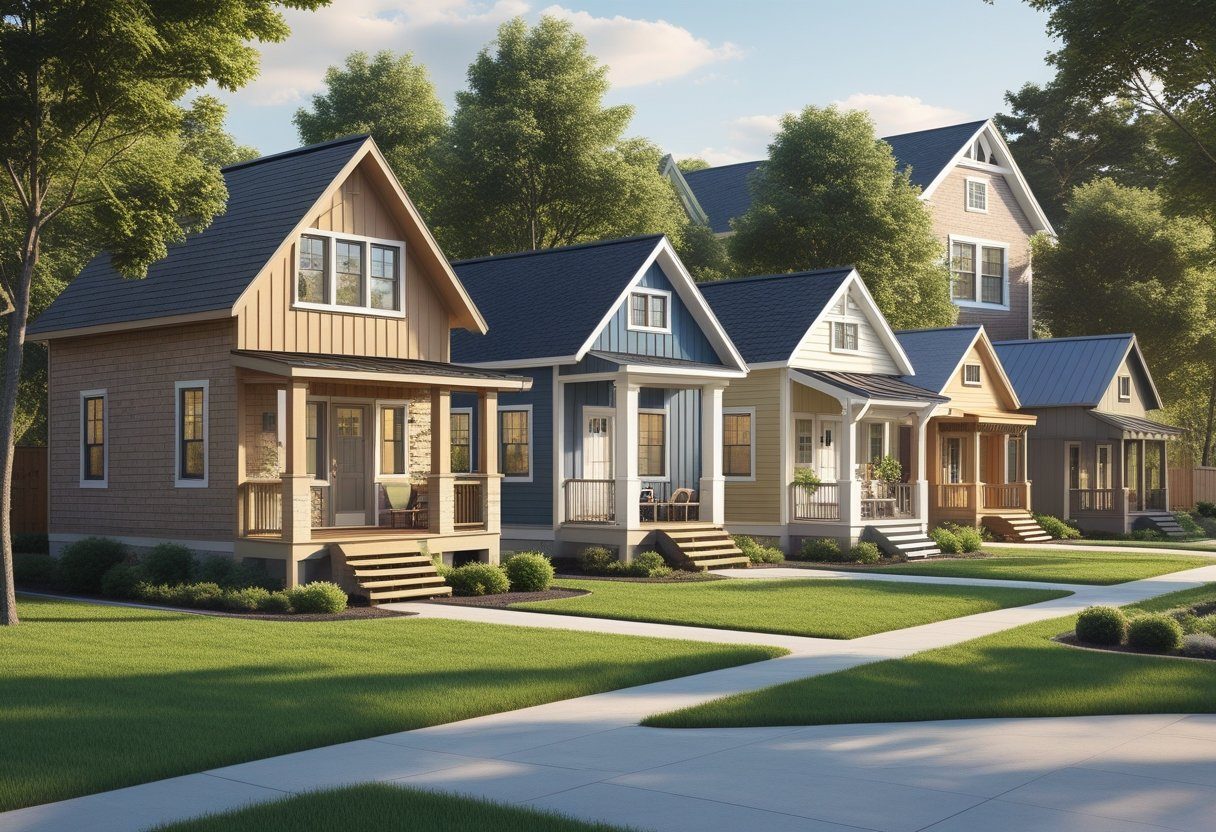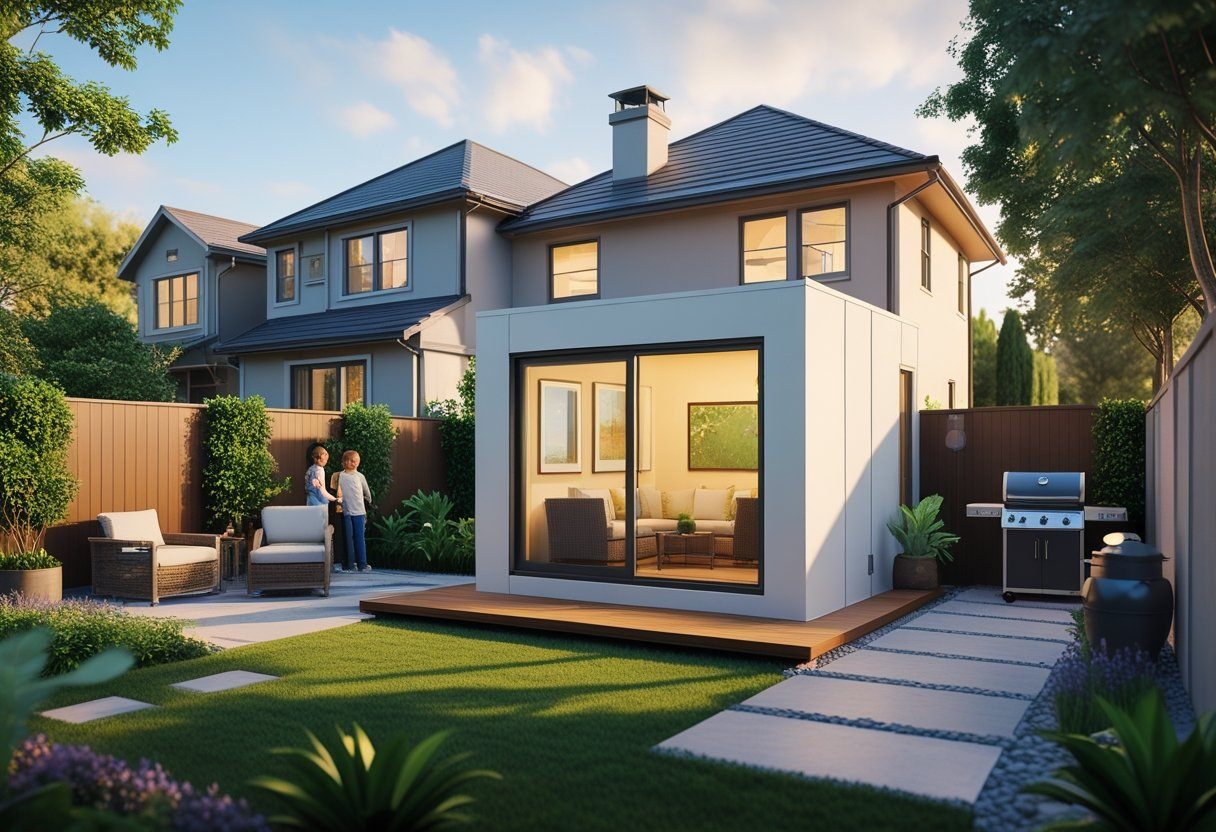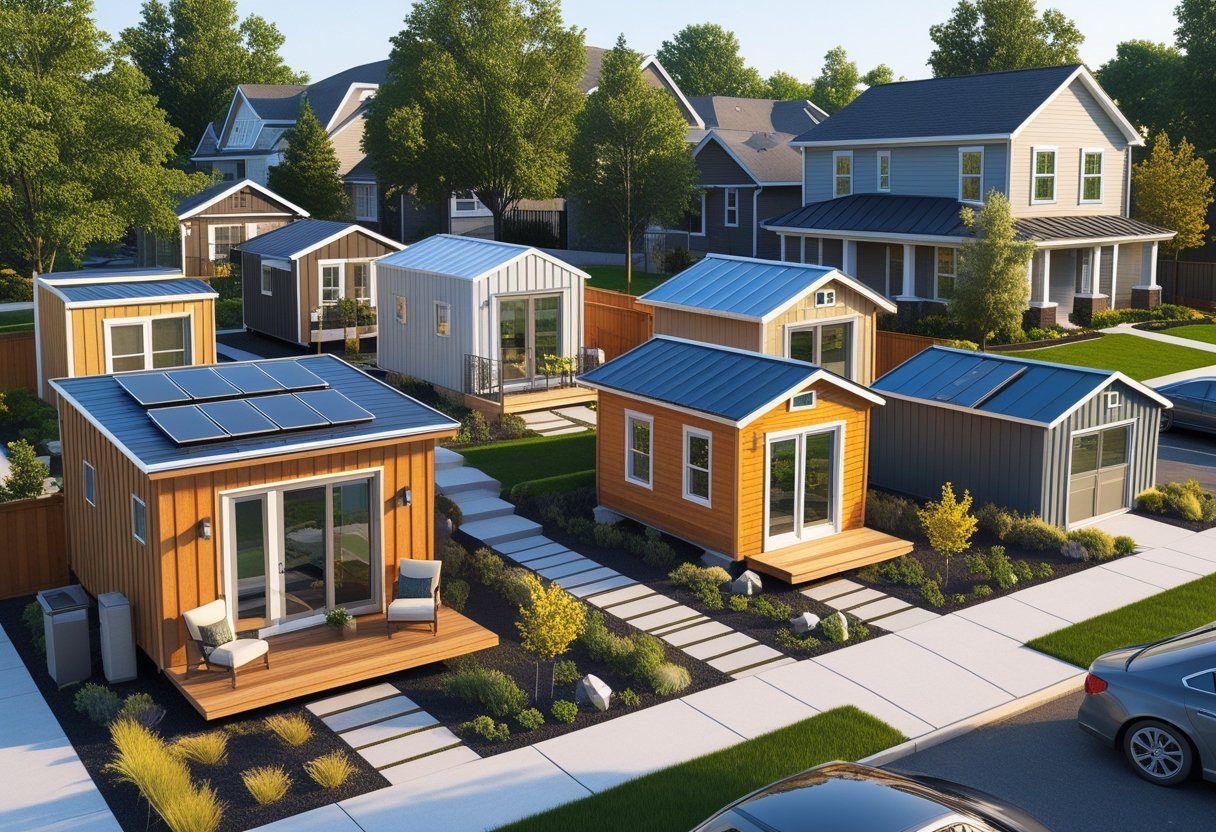Table of Contents
Examples of ADUs: Creative Uses and Real-Life Benefits
Accessory Dwelling Units are becoming incredibly popular as homeowners look for ways to add value to their property and create extra living space. ADU examples range from converted garages and basement apartments to standalone backyard cottages and above-garage studios. These small living spaces offer endless possibilities for rental income, housing family members, or creating a home office.

ADUs are the hottest real estate trend of 2025, and you have more options than you might think. You can transform your existing garage into a cozy studio apartment, build a tiny home in your backyard, or convert part of your main house into a separate unit. Each type offers different benefits depending on your budget, space, and goals.
The creativity behind modern ADUs is impressive. From high-end minimalist retirement units to contemporary communal living spaces, homeowners are finding smart ways to maximize their property’s potential while meeting housing needs in their communities.
Key Takeaways
- ADUs can be detached backyard units, garage conversions, or carved-out spaces within your existing home
- These units provide rental income opportunities and housing solutions for family members
- Local zoning laws and regulations vary significantly, so research requirements before building
What Are ADUs?
ADUs are small living spaces built on the same property as your main house. They come in different styles and have grown popular as cities change their housing rules.
Definition of Accessory Dwelling Units
An ADU is a complete living space that sits on your property alongside your main home. ADUs are small houses or apartments that exist on the same property lot as a single-family residence.
Your ADU needs its own kitchen, bathroom, and sleeping area. It can be attached to your main house or stand alone in your backyard.
Most cities limit ADU size to 800-1,200 square feet. Some allow units as small as 400 square feet.
You can build three main types:
- Detached units – separate buildings in your yard
- Attached units – connected to your main house
- Internal units – converted spaces inside your existing home
The key rule is that both your main house and ADU must share the same property lot. You can’t split the lot to sell the ADU separately.
Common ADU Terminology
Different regions use various names for accessory dwelling units. Granny flats are popular terms on the West Coast.
Carriage houses refer to detached ADUs that often sit above garages. These units copy the old carriage house style from the 1800s.
Casitas means “little houses” in Spanish. Phoenix recently legalized casitas as accessory dwelling units to help with housing needs.
Other common terms include:
- In-law suites – units for family members
- Backyard cottages – small detached homes
- Secondary units – formal planning term
- Laneway houses – units facing alleys
The official term “accessory dwelling unit” comes from city planning documents. Most people use simpler names in everyday talk.
History and Evolution of ADUs
ADUs were common before the 1950s when families often lived together across generations. Single-family zoning laws then banned these extra units for decades.
Cities started changing their rules in the 1980s as housing costs rose. California led the way with state laws that required cities to allow ADUs.
Recent changes include:
- 2016-2019: California streamlined ADU permits
- 2019: Oregon required cities to allow duplexes
- 2019: Minneapolis legalized duplexes and triplexes
- 2020s: Many cities adopted new zoning regulations for ADUs
ADUs have gained popularity due to rising real estate prices. People build them for rental income or to house family members affordably.
Popular Types of ADUs
Different types of ADUs offer unique benefits for homeowners looking to expand their living space. Each option varies in cost, privacy level, and construction requirements depending on your property layout and goals.
Detached ADU
Detached ADUs are standalone structures separate from your main house. These units function like tiny homes or casitas on your property.
You get maximum privacy with detached units. Both you and your tenants or family members have completely separate living spaces. This makes them perfect if you want to rent out the space or house extended family.
Key benefits include:
- Complete privacy for all residents
- Design flexibility to match your style
- Higher rental income potential
- Can accommodate larger floor plans
Detached ADUs typically require higher investment because they need their own utility connections. You’ll also need adequate yard space for construction.
These units work well as in-law suites when you want visiting family to feel independent. Some homeowners build them to look like carriage houses that complement their main home’s architecture.
Attached ADU
Attached ADUs share at least one wall with your primary residence. This connection helps reduce construction costs since utilities are already nearby.
You can create attached units by adding onto your home’s side or back. Some homeowners convert part of their single-family homes into what functions like duplexes.
Common attached ADU locations:
- Side additions to existing homes
- Rear extensions
- Above-garage spaces
- Converted portions of large homes
The shared wall design saves money on both construction and ongoing utility costs. You’ll have easier access between the main house and ADU compared to detached options.
Attached units work great for multigenerational living. Your elderly parents can have their own space while staying close enough for daily help when needed.
Garage Conversion ADU
Garage conversions are the most popular type of ADU because they’re cost-effective and use existing space efficiently. You transform an underused garage into comfortable living quarters.
This option costs less than building new structures. The basic shell already exists, so you mainly need to add insulation, flooring, and interior walls.
Garage conversion benefits:
- Lowest construction costs
- Faster completion timeline
- Uses existing foundation and roof
- Often includes electrical connections already
You can create a separate entrance for privacy and rental potential. Many garage conversions work perfectly as in-law suites or rental units.
The main drawback is losing parking and storage space. You’ll need to find alternative parking solutions for your vehicles.
Basement and Attic ADUs
Basement conversions create ADUs while using space you already have. This approach doesn’t reduce your yard space or change your home’s exterior appearance.
Basement ADUs work well in homes with full, unfinished basements. You’ll need to ensure proper lighting, ventilation, and moisture control for comfortable living.
Basement conversion considerations:
- Requires adequate ceiling height
- Needs proper egress windows for safety
- May need waterproofing improvements
- Often the most affordable ADU option
Attic conversions use your home’s upper level space. These units can offer great views and natural light when designed properly.
Both options help you maximize your existing square footage without expanding your home’s footprint. They’re ideal when local zoning limits how much you can build on your lot.
Real-World Examples of ADUs
Homeowners across the country are building everything from cozy backyard cottages for aging parents to sleek modern units that generate thousands in monthly rental income. These real examples show how different types of ADUs work in practice and what you can expect from your investment.
Backyard Cottages and Granny Flats
Your backyard could house a charming cottage that serves multiple purposes over the years. Many families start with a granny flat for aging parents, then convert it to rental income later.
Popular cottage features include:
- 400-800 square feet of living space
- Full kitchen and bathroom
- Separate entrance and utilities
- Small porch or patio area
In Portland, Oregon, a typical backyard cottage costs $80,000-$120,000 to build. These units rent for $1,200-$1,800 monthly, creating solid passive income streams.
The key advantage of a detached ADU is privacy. Your tenants or family members get independence while staying close. Contemporary and cottage-style designs blend well with most neighborhood styles.
Modern Micro Homes
You can build sleek, space-efficient units that maximize every square foot. Modern micro homes typically range from 300-600 square feet but feel much larger due to smart design.
Key design elements:
FeatureBenefitHigh ceilingsCreates spacious feelLarge windowsBrings in natural lightBuilt-in storageMaximizes floor spaceOpen floor plansImproves flow
These units appeal to young professionals and remote workers. In Seattle, a 400-square-foot modern ADU rents for $1,500-$2,000 monthly.
Your property value increases significantly with a well-designed micro home. Buyers love the flexibility and income potential these units provide.
Vacation and Rental ADUs
You can design your ADU specifically for short-term rentals through Airbnb or VRBO. These units focus on guest comfort and unique features that attract bookings.
Successful rental ADUs often include:
- High-end finishes and appliances
- Fast Wi-Fi and workspace areas
- Outdoor seating or fire pit
- Local artwork and decor
A Denver homeowner built a 500-square-foot accessory dwelling unit that earns $3,000-$4,000 monthly during peak seasons. The unit pays for itself within 5-7 years.
Location matters most for rental success. Units near downtown areas, beaches, or tourist attractions perform best. You’ll want to research local short-term rental regulations before building.
Benefits of Adding an ADU

ADUs offer financial benefits through increased property value and rental income opportunities. They also create flexible living solutions for families and help address local housing needs.
Boosting Property Value
Adding an ADU to your property can significantly increase your home’s market value. Most homeowners see their property value rise by 20-30% after building an ADU.
The extra square footage and additional living space make your property more attractive to buyers. ADUs increase property value while giving you more options for how to use your land.
Key factors that boost value:
- Additional livable square footage
- Separate entrance and utilities
- Potential rental income stream
- Flexibility for future owners
Your home improvement investment pays off both immediately and long-term. The ADU becomes a permanent asset that adds functionality to your property.
Generating Passive Income
ADUs provide a flexible, long-term revenue stream that can help offset mortgage payments and property expenses. Many homeowners earn $1,000-$3,000 per month renting their ADU.
This passive income can make a huge difference in your monthly budget. You can use the rental money to pay down your mortgage faster or save for other goals.
Income benefits include:
- Steady monthly rental payments
- Help covering property taxes and insurance
- Additional income during retirement
- Financial cushion for unexpected expenses
The rental income is especially valuable for people on fixed incomes. Your ADU tenant helps you maintain your home while providing them with affordable housing.
Supporting Multigenerational Living
ADUs enable families to expand beyond their primary home while maintaining privacy and independence. You can house aging parents, adult children, or other family members nearby.
This setup works well for families who want to stay close but need separate spaces. Your elderly parents get help when needed while keeping their independence.
Multigenerational benefits:
- Care for aging relatives without losing privacy
- Help adult children save money on rent
- Share household expenses and responsibilities
- Keep extended family connected
The flexible design lets you adapt the space as your family’s needs change over time. Your ADU can serve different purposes throughout the years.
Expanding Affordable Housing
Your ADU helps address the housing shortage in your community by adding affordable rental choices in single-family neighborhoods. Most ADUs offer more affordable rent than larger apartments.
These smaller units work perfectly for single people, couples, or small families who don’t need lots of space. ADUs typically measure between 600 and 1,000 square feet.
Housing benefits:
- Creates affordable options in expensive neighborhoods
- Provides starter homes for young renters
- Adds housing without major neighborhood changes
- Offers alternatives to large apartment buildings
Your ADU gives renters access to neighborhoods that might otherwise be too expensive. This helps create more diverse and inclusive communities.
Design Considerations for ADUs

Smart design choices can transform limited square footage into a comfortable living space that meets modern needs. Key elements include clever storage solutions, multi-functional furniture, and current architectural styles that maximize both function and appeal.
Maximizing Small Spaces
Small ADUs require creative solutions to make every square foot count. Open floor plans eliminate unnecessary walls and create the illusion of more space.
Storage Solutions:
- Built-in cabinets that reach the ceiling
- Under-stair storage compartments
- Fold-down desks and Murphy beds
- Multi-purpose furniture with hidden storage
Vertical space becomes your best friend in tiny homes. High ceilings with loft areas can double your usable space without increasing the footprint.
Light colors and large windows make rooms feel bigger than they actually are. Maximizing space requires careful planning of each design element.
Multi-functional rooms work well in compact layouts. A living room that converts to a bedroom or dining area that doubles as a workspace maximizes functionality.
Popular Features and Amenities
Modern ADU designs focus on comfort and convenience within limited space. High-quality finishes make small spaces feel luxurious rather than cramped.
Essential Features:
- Full-size appliances in compact kitchens
- Walk-in showers with glass doors
- In-unit laundry hookups
- Private outdoor spaces or patios
Smart home technology appeals to tech-savvy renters. Programmable thermostats, keyless entry, and USB outlets throughout the unit add modern convenience.
Energy-efficient features reduce utility costs for both you and your tenants. LED lighting, Energy Star appliances, and good insulation make the space more affordable to operate.
Design considerations must include required elements like full bathrooms, kitchens, and sleeping areas while adding desirable amenities.
Trends in ADU Architecture
Contemporary ADU designs blend modern aesthetics with practical functionality. Clean lines, large windows, and mixed materials create appealing exteriors.
Current Style Trends:
- Industrial elements like exposed beams
- Farmhouse details with board-and-batten siding
- Mid-century modern flat roofs
- Scandinavian minimalism with natural wood
Sustainable materials appeal to environmentally conscious renters. Reclaimed wood, bamboo flooring, and low-VOC paints create healthy living spaces.
Indoor-outdoor living connections work well in mild climates. Sliding glass doors, covered porches, and outdoor kitchens extend the living space beyond the interior walls.
ADU design requires balancing aesthetics with functionality while staying within local building codes. Your home improvement project should complement your main house while maintaining its own distinct character.
Regulations and Zoning for ADUs
Zoning laws determine where ADUs can be built on your property and what restrictions apply. Most regulations focus on size limits, setback requirements, and parking rules to maintain neighborhood standards while addressing the housing shortage.
Typical Zoning Codes for ADUs
Most cities allow ADUs in single-family residential zones, but each area has different rules. Zoning regulations differ by city and town and control where you can build and how big your unit can be.
Size restrictions typically limit ADUs to 800-1,200 square feet. Some areas base the limit on a percentage of your main house size.
Setback requirements dictate how far your ADU must sit from property lines. You might need 5-10 feet from side boundaries and 15-20 feet from the rear property line.
Height limits usually cap ADUs at 16-20 feet or two stories maximum. This prevents units from blocking neighbors’ views or sunlight.
Parking requirements vary widely. Urban areas near transit might waive parking completely. Other zones require one space per ADU bedroom.
States like California have passed laws to make ADU rules less strict. California mandates that local jurisdictions allow ADUs in single-family residential zones to help create more affordable housing options.
Permitting and Approval Processes
Start by visiting your local planning department’s website to check what types of ADUs your zone allows. The approval process usually takes 2-6 months depending on your city’s workload.
You’ll need to submit architectural plans, site surveys, and engineering reports. Most areas require plans that show electrical, plumbing, and structural details.
Building permits cost $500-$5,000 depending on your ADU’s size and complexity. Some cities have reduced fees to encourage affordable housing development.
Plan review takes 4-8 weeks in most areas. Cities like Los Angeles have streamlined this process, and permits move through the system faster now.
Your local building department will schedule inspections during construction. Expect inspections for foundation, framing, electrical, plumbing, and final occupancy.
Addressing Common Challenges
Parking often creates the biggest headaches for ADU projects. If your property lacks space for additional parking, consider applying for a waiver in transit-friendly areas.
Setback violations happen frequently on smaller lots. You might need to request a variance if your planned ADU sits too close to property lines.
Utility connections can get expensive if your main electrical panel or sewer line needs upgrades. Budget extra for these potential costs early in planning.
Neighbor concerns about density and traffic sometimes delay approvals. Address these by choosing designs that match your neighborhood’s style and scale.
Overly restrictive zoning standards in some areas make ADUs nearly impossible to build. Consider working with local advocacy groups pushing for housing reform.
Design review boards in historic districts add extra steps to approval. Plan for 1-3 additional months if your area has architectural review requirements.
Height restrictions on sloped lots can limit your options. Work with an architect who understands how to maximize space within local limits.
Frequently Asked Questions
Building an ADU involves navigating costs, design choices, and legal requirements that vary by location. Budget-friendly options start around $50,000, while grants and financing help offset expenses in California and other states.
How can I build an ADU on a budget?
You can build an ADU on a budget by choosing garage conversions or prefab units. Converting your existing garage into an ADU costs less than building from scratch since the structure already exists.
Prefab ADUs offer another money-saving option. These factory-built units reduce construction time and labor costs compared to custom builds.
Consider doing some work yourself if you have construction skills. Simple tasks like painting or basic landscaping can cut your total expenses.
Three main financing options help fund ADU projects: cash, home equity lines of credit, or cash-out refinances. A HELOC lets you borrow against your home’s value at lower interest rates than personal loans.
Keep your design simple to save money. Basic layouts with standard materials cost less than custom features or high-end finishes.
What are some cool backyard ADU designs?
Modern cube designs create clean lines with large windows and flat roofs. These minimalist ADUs work well in contemporary neighborhoods and maximize natural light.
Tiny house-style ADUs pack smart storage into small spaces. You’ll find fold-down beds, built-in seating with storage, and compact appliances that don’t sacrifice function.
Two-story ADUs make the most of small lots. The ground floor can house living areas while bedrooms go upstairs, giving you more space without a larger footprint.
Barn-style ADUs bring rustic charm to your backyard. High ceilings and exposed beams create an open feel that works for both living and workspace uses.
Container ADUs repurpose shipping containers into unique homes. These eco-friendly options cost less than traditional construction and can be stacked or arranged in creative ways.
What’s the deal with grants for constructing ADUs in California?
California offers various local grants and incentive programs to encourage ADU construction. Many cities provide reduced permit fees or expedited approval processes to make building easier.
Some cities offer direct financial assistance for ADU projects. Los Angeles has provided grants up to $75,000 for qualifying homeowners who commit to affordable rental rates.
You might qualify for state-backed financing programs that offer low-interest loans. These programs often target homeowners who will rent their ADUs at below-market rates.
Property tax incentives help offset construction costs. Many jurisdictions delay reassessment of your property value for several years after ADU completion.
Utility rebates can reduce your building costs. Electric companies often provide incentives for energy-efficient appliances and solar installations in new ADUs.
What should I know about the legal requirements for ADUs?
You don’t need a minimum lot size to build an ADU in California. State law removed this requirement to encourage more ADU construction.
You must live on the property as the owner in either the main house or the ADU. This owner-occupancy rule applies in most areas.
Your homeowners association cannot stop you from building an ADU. California state law overrides HOA restrictions on ADU construction.
Parking requirements vary by location and transit access. Many areas have eliminated parking requirements for ADUs near public transportation.
You can build both an ADU and Junior ADU on the same property. This allows for multiple rental income streams or housing family members.
Can you give examples of ADUs that have been built in urban areas?
Portland has thousands of ADUs built in narrow urban lots. Many homeowners convert basements or build small detached units in tight backyard spaces.
San Francisco ADUs often use vertical space with two-story designs. Rooftop ADUs above garages are popular in areas with limited yard space.
Seattle’s urban ADUs include converted mother-in-law apartments and basement units. Many feature separate entrances to maintain privacy from the main house.
Denver’s urban ADUs range from converted garages to new construction. Alley-accessed ADUs work well in neighborhoods with rear-lane infrastructure.
Los Angeles has seen explosive ADU growth with creative designs. Homeowners build above existing structures or convert unused spaces like pool houses.
Are there states where building an ADU could be tricky?
Some states have restrictive zoning laws that limit ADU construction. Local municipalities may prohibit secondary units or require special permits that are hard to obtain.
HOA restrictions in certain states can block ADU projects. While California limits HOA power over ADUs, other states allow associations to maintain stricter rules.
Rural areas often lack proper utility infrastructure for ADUs. You might need expensive septic systems or well water connections that increase costs significantly.
Historic districts frequently have design restrictions that complicate ADU construction. You may need to match architectural styles or use specific materials that cost more.
States with harsh winters require additional insulation and heating systems. These climate considerations can increase construction costs and ongoing utility expenses.
